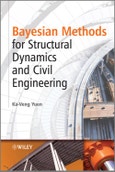Bayesian methods are a powerful tool in many areas of science and engineering, especially statistical physics, medical sciences, electrical engineering, and information sciences. They are also ideal for civil engineering applications, given the numerous types of modeling and parametric uncertainty in civil engineering problems. For example, earthquake ground motion cannot be predetermined at the structural design stage. Complete wind pressure profiles are difficult to measure under operating conditions. Material properties can be difficult to determine to a very precise level - especially concrete, rock, and soil. For air quality prediction, it is difficult to measure the hourly/daily pollutants generated by cars and factories within the area of concern. It is also difficult to obtain the updated air quality information of the surrounding cities. Furthermore, the meteorological conditions of the day for prediction are also uncertain. These are just some of the civil engineering examples to which Bayesian probabilistic methods are applicable.
- Familiarizes readers with the latest developments in the field
- Includes identification problems for both dynamic and static systems
- Addresses challenging civil engineering problems such as modal/model updating
- Presents methods applicable to mechanical and aerospace engineering
- Gives engineers and engineering students a concrete sense of implementation
- Covers real-world case studies in civil engineering and beyond, such as:
- structural health monitoring
- seismic attenuation
- finite-element model updating
- hydraulic jump
- artificial neural network for damage detection
- air quality prediction
- Includes other insightful daily-life examples
- Companion website with MATLAB code downloads for independent practice
- Written by a leading expert in the use of Bayesian methods for civil engineering problems
This book is ideal for researchers and graduate students in civil and mechanical engineering or applied probability and statistics. Practicing engineers interested in the application of statistical methods to solve engineering problems will also find this to be a valuable text.
Table of Contents
ContentsPreface
Nomenclature
1 Introduction
1.1 Thomas Bayes and Bayesian Methods in Engineering
1.2 Purpose of Model Updating
1.3 Source of Uncertainty and Bayesian Updating
1.4 Organization of the Book
2 Basic Concepts and Bayesian Probabilistic Framework
2.1 Conditional Probability and Basic Concepts
2.2 Bayesian Model Updating with Input-output Measurements
2.3 Deterministic versus Probabilistic Methods
2.4 Regression Problems
2.5 Numerical Representation of the Updated PDF
2.6 Application to Temperature Effects on Structural Behavior
2.7 Application to Noise Parameters Selection for Kalman Filter
2.8 Application to Prediction of Particulate Matter Concentration
3 Bayesian Spectral Density Approach
3.1 Modal and Model Updating of Dynamical Systems
3.2 Random Vibration Analysis
3.3 Bayesian Spectral Density Approach
3.4 Numerical Verifications
3.5 Optimal Sensor Placement
3.6 Updating of a Nonlinear Oscillator
3.7 Application to Structural Behavior under Typhoons
3.8 Application to Hydraulic Jump
4 Bayesian Time-domain Approach
4.1 Introduction
4.2 Exact Bayesian Formulation and its Computational Difficulties
4.3 Random Vibration Analysis of Nonstationary Response
4.4 Bayesian Updating with Approximated PDF Expansion
4.5 Numerical Verification
4.6 Application to Model Updating with Unmeasured Earthquake Ground Motion
4.7 Concluding Remarks
4.8 Comparison of Spectral Density Approach and Time-domain Approach
4.9 Extended Readings
5 Model Updating Using Eigenvalue-Eigenvector Measurements
5.1 Introduction
5.2 Formulation
5.3 Linear Optimization Problems
5.4 Iterative Algorithm
5.5 Uncertainty Estimation
5.6 Applications to Structural Health Monitoring
5.7 Concluding Remarks
6 Bayesian Model Class Selection
6.1 Introduction
6.2 Bayesian Model Class Selection
6.3 Model Class Selection for Regression Problems
6.4 Application to Modal Updating
6.5 Application to Seismic Attenuation Empirical Relationship
6.6 Prior Distributions - Revisited
6.7 Final Remarks
A Relationship between the Hessian and Covariance Matrix for Gaussian Random Variables
B Contours of Marginal PDFs for Gaussian Random Variables
C Conditional PDF for Prediction
C.1 Two Random Variables
C.2 General Cases
References
Index
Samples

LOADING...








